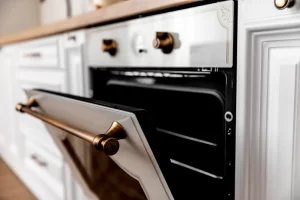If you’ve ever looked inside your oven and debated whether to brave the built-in self-cleaning cycle or reach for a can of chemical spray, you’re not alone. And if you’ve heard the warning that commercial oven cleaners can damage the enamel lining or even ruin the self-cleaning function altogether—you’re definitely not alone.
So, is it fact or fiction?
Let’s break it down and offer up some safer alternatives while we’re at it.
🔍 The Enamel Myth: Do Oven Cleaners Actually Damage the Interior?
Most ovens—especially self-cleaning ones—come coated with a special high-heat enamel. This enamel is engineered to withstand extreme temperatures, making it safe during high-heat cycles and everyday cooking spills.
The problem? Many chemical oven cleaners (like Easy-Off) are extremely alkaline, which helps break down grease and burnt-on food. But that same strength can degrade the enamel lining over time—especially if the cleaner is used frequently or not fully rinsed off.
While a one-time use likely won’t destroy your oven, repeat exposure can lead to pitting, discoloration, or even small chips in the enamel. That can make the oven harder to clean in the long run—and possibly shorten its lifespan.
⚠️ The Self-Cleaning Cycle + Chemical Cleaners = A Risky Combo
Here’s where things get a little more dangerous.
If you’ve used a commercial oven cleaner and then activate the self-cleaning mode without thoroughly removing all residue, you’re essentially baking harsh chemicals into the enamel. This can lead to:
- Noxious fumes
- White residue or streaking
- Damage to the temperature sensor
- In worst cases: enamel flaking or cracking
Most oven manufacturers warn against using chemical cleaners in self-cleaning ovens for this exact reason. Check your manual—many will void the warranty if damage is caused by commercial sprays.
🔥 Cleaning Methods by Oven Type
Not all ovens are created equal, and cleaning them safely starts with knowing what you’re working with.
Self-Cleaning Ovens
- Use the built-in cycle—without any chemical assistance.
- Before starting, remove racks and large food debris.
- Wipe interior with a damp cloth after the cycle is complete.
Convection Ovens
- Often self-cleaning, but check the manual.
- Avoid using harsh cleaners near the convection fan.
- If manual cleaning, go with gentle abrasives and natural cleaners.
Gas Ovens
- Turn off the gas and pilot light before cleaning.
- Avoid spraying directly on gas ports or igniters.
- Best to use non-toxic methods like baking soda paste.
Electric Ovens (Non-Self-Cleaning)
- You have more flexibility but still avoid extremely caustic products.
- If using commercial cleaner, rinse thoroughly with a damp cloth.
✅ Safer Alternatives That Actually Work
You don’t need to resort to harsh chemicals to clean your oven effectively. Try these gentler options that won’t wreck the enamel or ruin your warranty:
🧽 Baking Soda Paste
- Mix baking soda with water into a spreadable paste.
- Apply to oven surfaces and let sit overnight.
- Wipe clean with a damp cloth and follow up with vinegar spray to remove any residue.
🌫️ Vinegar Steam
- Heat an oven-safe bowl filled with equal parts vinegar and water at 250°F for 20–30 minutes.
- Let cool slightly, then wipe loosened grime with a cloth or sponge.
🔧 Plastic Scrapers
- Great for stuck-on gunk—won’t scratch enamel.
- Avoid metal scrapers or steel wool (they’re enamel killers).
🕓 Pro Tip: Timing Is Everything
One of the biggest mistakes people make when cleaning their oven? Starting while it’s too hot or too cold.
A slightly warm oven is your sweet spot. It helps loosen grime and softens grease, making natural cleaning agents like baking soda more effective—without the hazard of burns or baked-on cleaning paste.
Ideal timing: Let the oven cool to just above room temperature (you should be able to touch the inside with a bare hand comfortably).
💡 Final Thoughts
Chemical oven cleaners aren’t inherently evil—but they’re not the safest choice either, especially if you have a self-cleaning model. If you do use them, use sparingly, rinse thoroughly, and never pair them with the self-cleaning function.
With a little patience and the right natural tools, your oven can sparkle without a single spray of noxious foam.



